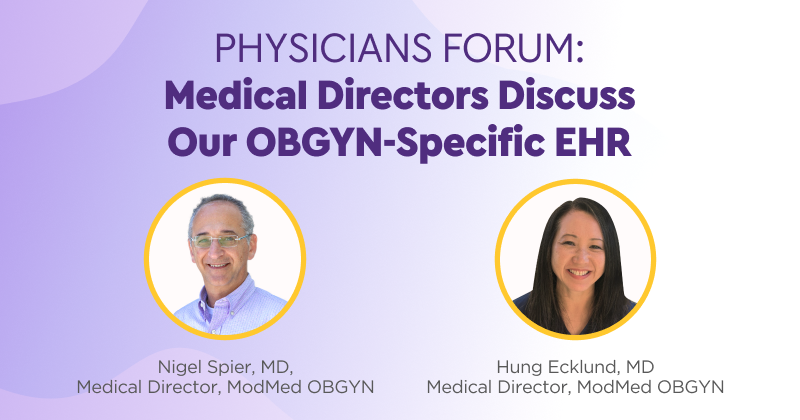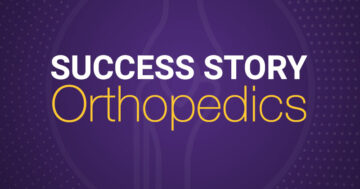OBGYN Medical Directors Share How a Specialty-Specific EHR Can Help You Refocus on Patient Care

Dr. Hung Ecklund and Dr. Nigel Spier provide solutions for common workflow and patient engagement challenges
If your EHR isn’t specifically designed for OBGYNs, you might grapple with inefficiencies. Endlessly scrolling for the information you need can be time-consuming. Disorganization can negatively impact patient engagement. Inaccurate coding can complicate and delay billing. These challenges are enough to put anyone on the path to burnout.
That’s why ModMed® OBGYN Medical Directors hosted a webinar to discuss how a specialty-specific EHR can help you improve workflows and refocus on what matters most — caring for your patients. Check out some of the takeaways from their conversation.
Work with the right information at the right time
According to a poll taken during our webinar, pain points that are common with OBGYNs like you include:
- Clunky user interfaces
- Tedious manual data entry
- Disconnected systems
- Lack of mobile applications
These outdated ways of working can hurt productivity and keep you in the office well past closing.
ModMed Medical Director of OBGYN Hung Ecklund, MD, knows the feeling. In her practice, she often wished for an EHR that could help minimize information overload and allow her to see the relevant data up front. She knew a distracting EHR was making it harder to be truly present and connect well with patients.
Dr. Ecklund was part of the physician team that built the ModMed OBGYN suite of solutions. She and ModMed Medical Director of OBGYN Nigel Spier, MD, used their own experiences as physicians in private practice to help develop the workflows in our EHR, EMA®, that support how doctors like you really work.
EMA is designed to provide the relevant data in real time as you document on a tablet or desktop at the point of physician-patient interaction rather than retrofitting data from a generic workflow. Its adaptive learning capabilities include remembering your frequently used actions and preferences. For example, if your patient comes in for a well-woman visit and you find a lump during a breast exam, you don’t have to go back to a separate template. You can follow a linear workflow that facilitates easy access to your potential next action, like ordering an ultrasound.
As OBGYN evolves, practicing physicians Dr. Ecklund and Dr. Spier continue attending industry conferences and visiting practices to provide valuable feedback to ModMed software engineers. These efforts keep our software aligned with your practice’s changing demands.
“Just the other day, we got feedback that doctors in one practice routinely finish their notes by 5PM and get to go home to their families. I heard that and had this great feeling all day.”
—Dr. Hung Ecklund, ModMed OBGYN Medical Director
Help patients cut through confusion
Streamlining documentation can also help you reconnect with patients. Some OBGYNs find that patients need diagnoses, medical terminology or treatment plans clarified, especially if the issues are complex.
Visual support in your EHR can help you explain things in a way patients understand. Showing ultrasound images on a tablet may help illustrate conditions better than verbal explanations. With photos integrated into your EHR, you can access them from the patient’s chart without leaving EMA.
Dr. Ecklund finds that some patients don’t always understand dilation. She uses her fingertips or a stylus to draw on anatomical images or photos to illustrate activity in the uterus or where a baby’s head might be.
Patient engagement tools can also help clear up questions. Two-way messaging allows patients to send messages when it’s convenient for them and receive personalized responses. They can ask about test results, prescription refills and details they considered after their appointments.
On the practice side, it’s easier for your staff to support requests because patient engagement tools automate and streamline tasks like appointment reminders and payment notifications. You can stay focused on medical care because our Patient Collaboration tools help handle other communications.
“I always advocate for finding better solutions so physicians can make the most of technology and focus on patient care. Technology should be a tool and supplement, not a substitute for what you do.”
—Dr. Nigel Spier, ModMed OBGYN Medical Director
Reduce billing and coding complexity
Complex billing demands can threaten your practice’s revenue. As the old adage goes, “garbage in, garbage out.” If your EHR isn’t capturing the details of how you practice, you risk putting “garbage in.” Then, when your team submits claims, they may waste hours chasing down missing information. Or worse, they may have to deal with denials and delays. The time it takes to fix problems starts eating up more of your revenue.
Let’s say you have a patient who requires hysteroscopic resection for submucous fibroids. With an EHR system that captures the details of the treatment and diagnosis as you go, your billing submissions are more likely to be accurate and complete.
“Our EHR follows E/M guidelines in the background to auto-suggest codes based on your documentation. We’ve seen that users have lower denial rates because their documentation is clear and justifies the billing codes. It’s great for a practice to get paid for their work.”
—Dr. Hung Ecklund, ModMed OBGYN Medical Director
Streamline your OBGYN practice
Generic EHRs — and the manual work they may cause — can lead to physician frustration, patient disengagement and lost revenue. Working in an EHR tailored for OBGYNs can help you avoid these challenges. Features like real-time documentation and information exchange from patient records to billing can simplify tasks for you and your team.
Want to see how your OBGYN practice could benefit from our specialty-specific EHR? Book a demo now.
This blog is intended for informational purposes only and does not constitute legal or medical advice. Please consult with your legal counsel and other qualified advisors to ensure compliance with applicable laws, regulations and standards.







